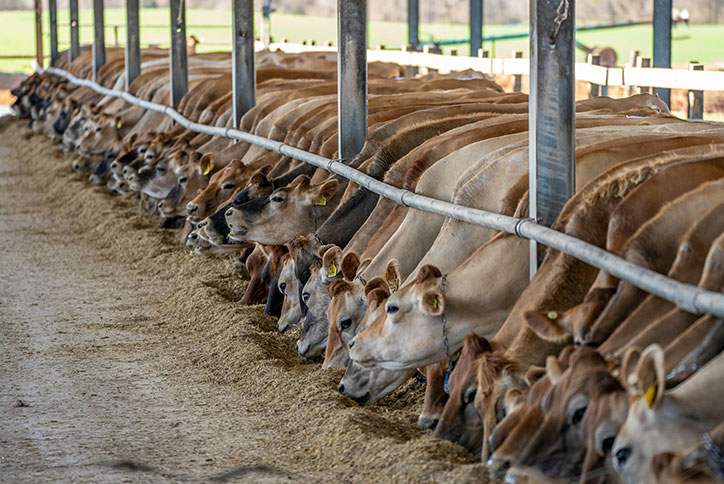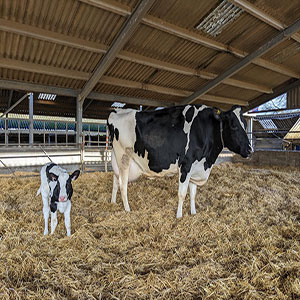Monopropylene Glycol as a Glucose Precursor
Monopropylene Glycol as a Glucose Precursor and Its Role in the Metabolism of Transition Cows
Introduction
The transition period in dairy cows, spanning approximately three weeks before and after calving, is a critical phase that determines the metabolic health and productivity of the animal. During this time, cows undergo significant physiological changes, including increased energy demands due to lactation initiation and decreased dry matter intake (DMI). These factors make dairy cows highly susceptible to metabolic disorders such as ketosis, fatty liver syndrome, and negative energy balance (NEB).
To mitigate these risks, nutritional strategies often involve the use of glucose precursors, compounds that can be metabolized to produce glucose, thereby supporting energy balance. One such compound is monopropylene glycol (MPG), also known as 1,2-propanediol, a commonly used feed additive in dairy cow nutrition. MPG serves as an efficient precursor for gluconeogenesis, helping to prevent metabolic disorders associated with energy deficiency.
This article explores the biochemical role of MPG in glucose metabolism, its physiological effects on transition cows, and its application in modern dairy management.
The Metabolic Challenges of Transition Cows
Negative Energy Balance (NEB) and Ketosis
During early lactation, dairy cows experience a sharp increase in energy demands, primarily for milk synthesis. However, due to reduced DMI, they often fail to meet these requirements, resulting in negative energy balance (NEB). To compensate, cows mobilize body fat reserves, leading to increased concentrations of non-esterified fatty acids (NEFAs) in the bloodstream. While some NEFAs are used for energy production, excess amounts are converted into ketone bodies, such as beta-hydroxybutyrate (BHB) and acetone, potentially leading to ketosis.
Ketosis can be classified into:
• Subclinical ketosis (SCK): Characterized by elevated BHB levels without apparent clinical signs.
• Clinical ketosis: Marked by significant weight loss, reduced appetite, decreased milk yield, and neurological symptoms in severe cases.
If untreated, ketosis can result in fatty liver syndrome, where excessive fat accumulates in hepatocytes, impairing liver function and worsening energy imbalance.
Importance of Gluconeogenesis
Since glucose is the primary energy source for the mammary gland and other tissues, its availability is crucial. Unlike monogastric animals, ruminants have limited direct glucose absorption from the diet, relying heavily on hepatic gluconeogenesis. This process primarily utilizes precursors like:
• Propionate (from ruminal fermentation)
• Amino acids (from protein breakdown)
• Lactate (from anaerobic glycolysis)
• Glycerol (from fat mobilization)
MPG plays a key role in this metabolic framework as a glucogenic compound that supports energy balance in transition cows.

Monopropylene Glycol: A Glucose Precursor
Chemical and Physical Properties
Monopropylene glycol (MPG) is a colorless, odorless, hygroscopic liquid with the chemical formula C₃H₈O₂. It is structurally similar to glycerol and is metabolized differently from propylene glycol (PG), which contains both 1,2-propanediol and 1,3-propanediol isomers. MPG is highly soluble in water and can be included in liquid or solid feed formulations.
Metabolism of MPG in Dairy Cows
Upon ingestion, MPG is absorbed from the gastrointestinal tract and metabolized in the liver through the following pathway:
• Conversion to Lactaldehyde
• MPG undergoes oxidation via alcohol dehydrogenase, forming lactaldehyde.
• Transformation into Lactic Acid
• Lactaldehyde is quickly converted into lactic acid, a key gluconeogenic substrate.
• Entry into the Gluconeogenic Pathway
• Lactic acid is transported into hepatocytes, where it enters the Cori cycle and is converted into pyruvate.
• Pyruvate is further transformed into oxaloacetate, which fuels gluconeogenesis to produce glucose.
This metabolic route enables MPG to function as an efficient glucose precursor, directly supporting hepatic glucose synthesis.
Comparison with Other Glucogenic Precursors
MPG offers distinct advantages over other glucogenic precursors due to its fast hepatic metabolism and high efficiency in glucose production.
Physiological Benefits of MPG in Transition Cows
1. Prevention and Treatment of Ketosis
Studies have shown that feeding MPG reduces blood BHB and NEFA concentrations, mitigating the risk of subclinical and clinical ketosis. This occurs due to its rapid gluconeogenic effect, which enhances insulin secretion and reduces excessive lipolysis.
MPG particularly effective in:
• Multiparous cows with high body condition scores (BCS >3.5)
• Cows with a history of ketosis or metabolic disorders
• Herds with high subclinical ketosis incidence (>15%)
2. Improved Milk Production and Energy Balance
By increasing glucose availability, MPG supports lactogenesis and enhances milk yield. Additionally, glucose-dependent hormones such as insulin-like growth factor-1 (IGF-1) play a role in improving fertility outcomes, reducing postpartum anestrus, and supporting reproductive performance.
3. Reduction of Fatty Liver Syndrome
Since MPG minimizes excessive NEFA mobilization, it lowers triglyceride accumulation in hepatocytes, decreasing the risk of fatty liver. Healthier liver function enhances metabolic efficiency, reducing the incidence of secondary conditions like immune suppression and mastitis.
Application in Dairy Management
Dosage and Administration
MPG can be administered in several ways:
• Top-dressing in feed: 150–400 g/cow/day
• Oral drenching: 300–500 mL/day for 5–7 days (for high-risk cows)
• Incorporation into total mixed rations (TMR): Effective in maintaining glucose levels when supplemented consistently
Monitoring and Effectiveness
To assess the impact of MPG supplementation, key metabolic markers should be monitored:
• Blood BHB levels (<1.2 mmol/L preferred)
• Serum glucose levels (>3.0 mmol/L optimal)
• Liver triglyceride content (for fatty liver risk assessment)
• Milk yield and composition (fat-to-protein ratio should be monitored for ketosis risk)
Potential Risks and Limitations
While MPG is generally safe, excessive dosing can cause:
• Transient metabolic acidosis (due to lactic acid accumulation)
• Reduced feed intake (if palatability is affected)
• Diarrhea or mild digestive upset (in cases of excessive oral administration)
Conclusion
Monopropylene glycol is a highly effective glucose precursor that plays a vital role in maintaining energy balance in transition dairy cows. By enhancing hepatic gluconeogenesis, MPG reduces ketosis incidence, supports milk production, and improves overall metabolic health. When integrated into a well-managed feeding program, it serves as a key nutritional strategy for optimizing cow performance during the transition period.(Monopropylene Glycol as a Glucose Precursor)
Useful content:


